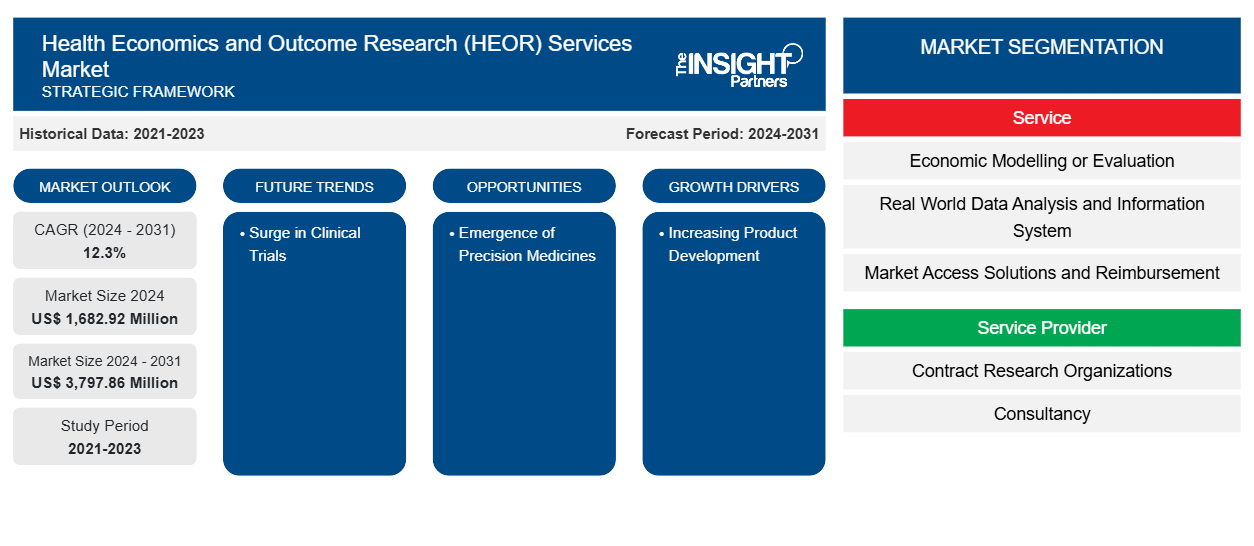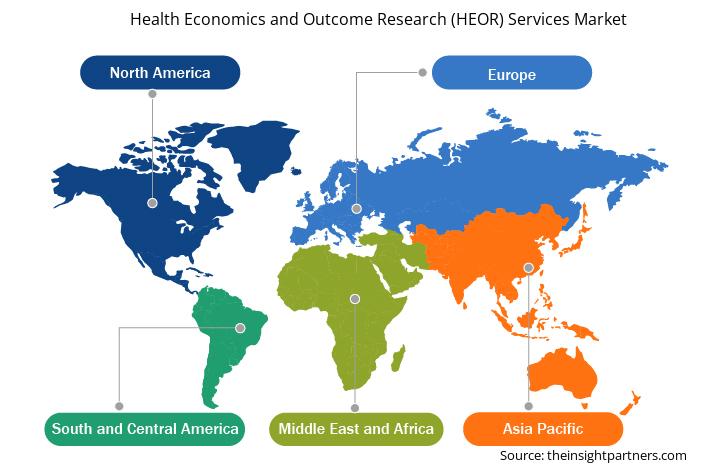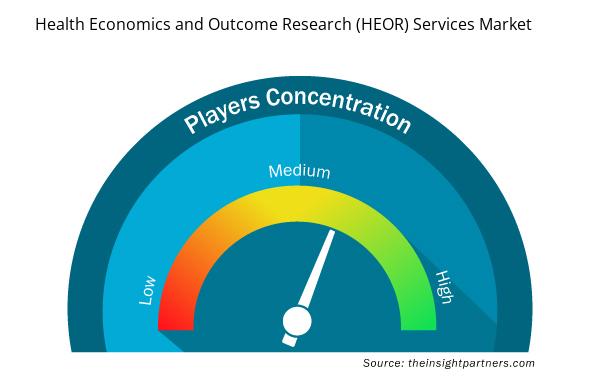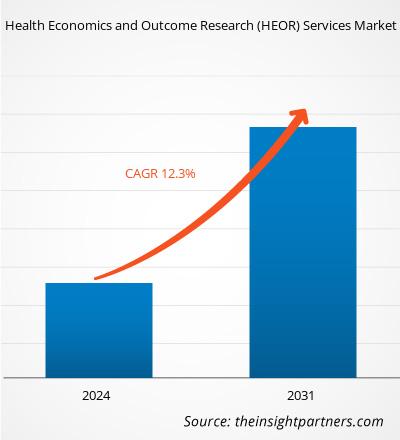The health economics and outcome research (HEOR) services market size is projected to reach US$ 3,797.86 million by 2031 from US$ 1,682.92 million in 2024. The market is expected to register a CAGR of 12.3% during 2024–2031. Digitalization in healthcare is likely to remain a key trend in the health economics and outcome research (HEOR) services market.
Health Economics and Outcome Research (HEOR) Services Market Analysis
The health economics and outcome research (HEOR) services market is expected to witness substantial growth in the coming years due to increasing demand for cost-effective healthcare solutions and the need to demonstrate the value of medical interventions. The market is poised for significant growth with an increasing number of drug approvals and substantial investments in research and development within the pharmaceutical sector. As healthcare systems worldwide strive to balance cost and quality, the demand for HEOR services is expected to continue its upward trajectory, offering valuable insights into the economic and clinical outcomes of medical treatments.
Health Economics and Outcome Research (HEOR) Services Market Overview
HEOR services are essential for evaluating the economic impact and effectiveness of medical interventions, thereby informing healthcare policies and treatment decisions. The market is driven by the pharmaceutical and biotechnology sectors, which rely on HEOR to demonstrate the value of their products to payers and regulators. Additionally, the growing number of clinical trials and the integration of real-world evidence (RWE) into healthcare decision-making are contributing to market expansion.
One of the most important developments in HEOR is the growing use of RWE in healthcare decision-making in Germany. RWE is being utilized more and more to supplement randomized controlled studies and research as it offers important insights into the efficacy and cost-effectiveness of healthcare interventions in real-world settings. Cegedim Health Data has expanded its European database, THIN, to include German real-world data (RWD) in November 2023. With over 10 million active EHRs annually, THIN serves as a key source of anonymized longitudinal data for various healthcare stakeholders, including pharmaceutical companies and researchers. The standardized data model of THIN allows for easy comparisons and is recognized for its statistical robustness, contributing to improvements in patient care and public health outcomes.
Customize This Report To Suit Your Requirement
You will get customization on any report - free of charge - including parts of this report, or country-level analysis, Excel Data pack, as well as avail great offers and discounts for start-ups & universities
Health Economics and Outcome Research (HEOR) Services Market: Strategic Insights

- Get Top Key Market Trends of this report.This FREE sample will include data analysis, ranging from market trends to estimates and forecasts.
You will get customization on any report - free of charge - including parts of this report, or country-level analysis, Excel Data pack, as well as avail great offers and discounts for start-ups & universities
Health Economics and Outcome Research (HEOR) Services Market: Strategic Insights

- Get Top Key Market Trends of this report.This FREE sample will include data analysis, ranging from market trends to estimates and forecasts.
Health Economics and Outcome Research (HEOR) Services Market Drivers and Opportunities
Increasing Product Development Bolsters Market Growth
The broad healthcare industry has a constant demand for product developments that offer quality products. Moreover, the rising incidence of acute and chronic diseases, growing demand for minimally invasive treatments, rising healthcare expenditure, and evolving technologies are propelling the demand for healthcare product development. The upgrading healthcare systems and increasing technological development have offered technologies such as genomics, artificial intelligence, minimally invasive services, point-of-care services, and robotics treatments.
The main focus of the manufacturer is to offer cost-effective and efficient products in the market. Product development leads to better communication between the healthcare provider and patients. This results in an increased awareness and knowledge, leading the company and industrial growth. Health economics and their outcomes are studied to drive better business. Designing a product and its lifecycle becomes difficult for market players in the developmental process. Various companies outsource HEOR services to understand regulations, healthcare coverage, and access decisions and identify the intervention that would benefit the specific populations of patients. The HEOR's most essential service is helping players fill the gap between clinical trials and actual health outcomes.
Startup registrations have increased, and North America, Europe, and Asia Pacific have registered various startups post-COVID-19 pandemic. The number increased significantly during the COVID-19 pandemic, resulting in increased product developments. As these players are new to the market, they require proper guidance and understanding of the market; also, they need to outsource HEOR services. Various well-established companies also outsource HEOR services to save the cost of production. The HEOR service providers help pharmaceutical, biotechnology, and medical device companies explain the value of their innovations to their respective stakeholders, such as physicians, payers, and patients. Thus, increasing product development is driving demand for HEOR services and fuels market growth.
Emergence of Precision Medicines to Create Growth Opportunities
Precision medicine is an emerging segment in the healthcare industry. Research and developments have shown promising results in the betterment of people and health improvement. However, despite various developments and improvements, there is a lack of evidence, thresholds, and reimbursement scenarios. Various researchers, payers, healthcare service providers, and market players are working to deploy new insights into personalized or precision medicine applications in early drug development and their consequences for health technology assessment. These provide ample growth opportunities for HEOR service providers to enhance their services for strategy and consulting, real-world evidence, modeling and microsimulation, and evidence synthesis associated with precision medicine. In addition, the HEOR guidelines and frameworks can clarify outcomes and their impacts caused by regulatory and reimbursement policies for precision medicine applications. Moreover, they are expected to guide research investments to improve the appropriate use of precision medicine.
The HEOR services market is expected to have vital growth opportunities in North America and Europe. These two regions are incorporating precision medicine into hospital settings. For instance, Europe has initiated the 1+ Million Genomes initiative, aiming to sequence one million genomes by 2022 and use the potential of genomics to improve disease prevention and enable more personalized treatments. Thus, the emergence of precision medicine is expected to provide vital growth opportunities for the market during the forecast period.
Health Economics and Outcome Research (HEOR) Services Market Report Segmentation Analysis
Key segments that were the foundation of health economics and outcome research (HEOR) services market analysis are service, service provider, and end user.
- Based on service, the health economics and outcome research (HEOR) services market is categorized into economic modelling or evaluation, real world data analysis and information system, market access solutions and reimbursement, clinical outcome, and others. The economic modelling or evaluation segment held the largest share of the market in 2024.
- By service provider, the market is bifurcated into consultancy and contract research organizations. The contract research organizations segment held a larger health economics and outcome research (HEOR) services market share in 2024.
- In terms of end user, the health economics and outcome research (HEOR) services market is segmented into healthcare providers, healthcare payers, biotech/pharma companies, and government organizations. The biotech/pharma companies segment dominated the market in 2024.
Health Economics and Outcome Research (HEOR) Services Market Share Analysis by Geography
The geographic scope of the health economics and outcome research (HEOR) services market report is divided into five regions: North America, Asia Pacific, Europe, Middle East & Africa, and South & Central America.
North America held a significant share of the market in 2024. The regional market growth is driven by growing demand for HEOR services by the healthcare market players, growing support from the government to provide cost-effective healthcare service, increasing strategic developments by the HEOR players to enhance services, and a growing healthcare industry that demands frameworks and guidelines based on the real-world data for their business models.
Increased research and development investments by the US government and market players are fueling the HEOR services market. According to the National Center for Science and Engineering Statistics (NCSES), businesses contributed US$ 130 billion to research in 2021, which accounted for 49% of all research spending in the US and 22% of all corporate funding for research and development. 77% of all US research and development in 2021 was conducted by businesses, totaling US$ 609 billion.
Canada is the fastest-developing country in North America and has a well-established healthcare system, which is among the best healthcare systems globally. The country has the Canadian Center for Health Economics (CCHE) for HEOR services. The system is highly regulated and thus offers world-class healthcare services. Public organizations and companies widely offer healthcare services in the country.
The government of Canada is making large investments in clinical trials to develop new instruments and therapies. According to the Canadian Institutes of Health Research (CIHR) article published in August 2024, more than US$ 103.1 million has been allocated for 36 clinical trial projects since 2022 through the CIHR Clinical Trials Fund, Canada's Strategy for Patient-Oriented Research, and Canada's Centre for Research on Pandemic Preparedness and Health Emergencies. Fourteen new clinical studies aimed at addressing health emergencies and developing the life sciences industry are being supported by a recent investment of more than US$ 43 million. For a range of medical issues, these studies evaluate therapies, diagnostic procedures, and preventative measures.
Health Economics and Outcome Research (HEOR) Services Market Regional Insights
The regional trends and factors influencing the Health Economics and Outcome Research (HEOR) Services Market throughout the forecast period have been thoroughly explained by the analysts at Insight Partners. This section also discusses Health Economics and Outcome Research (HEOR) Services Market segments and geography across North America, Europe, Asia Pacific, Middle East and Africa, and South and Central America.

- Get the Regional Specific Data for Health Economics and Outcome Research (HEOR) Services Market
Health Economics and Outcome Research (HEOR) Services Market Report Scope
| Report Attribute | Details |
|---|---|
| Market size in 2024 | US$ 1,682.92 Million |
| Market Size by 2031 | US$ 3,797.86 Million |
| Global CAGR (2024 - 2031) | 12.3% |
| Historical Data | 2021-2023 |
| Forecast period | 2024-2031 |
| Segments Covered |
By Service
|
| Regions and Countries Covered | North America
|
| Market leaders and key company profiles |
Health Economics and Outcome Research (HEOR) Services Market Players Density: Understanding Its Impact on Business Dynamics
The Health Economics and Outcome Research (HEOR) Services Market is growing rapidly, driven by increasing end-user demand due to factors such as evolving consumer preferences, technological advancements, and greater awareness of the product's benefits. As demand rises, businesses are expanding their offerings, innovating to meet consumer needs, and capitalizing on emerging trends, which further fuels market growth.
Market players density refers to the distribution of firms or companies operating within a particular market or industry. It indicates how many competitors (market players) are present in a given market space relative to its size or total market value.
Major Companies operating in the Health Economics and Outcome Research (HEOR) Services Market are:
- PharmaLex GmbH,
- ICON Plc,
- IQVIA Holdings Inc,
- Syneos Health Inc,
- Optum Inc,
- Certara Inc,
Disclaimer: The companies listed above are not ranked in any particular order.

- Get the Health Economics and Outcome Research (HEOR) Services Market top key players overview
Health Economics and Outcome Research (HEOR) Services Market News and Recent Developments
The health economics and outcome research (HEOR) services market is evaluated by gathering qualitative and quantitative data post primary and secondary research, which includes important corporate publications, association data, and databases. A few of the developments in the health economics and outcome research (HEOR) services market are listed below:
- AmerisourceBergen Corporation completed the acquisition of PharmaLex Holding GmbH. The acquisition of PharmaLex enhances AmerisourceBergen's growth strategy by advancing its leadership in specialty services and global platform of pharma manufacturer services capabilities. (Source: AmerisourceBergen Corporation, Press Release, January 2023)
- Syneos Health announced an expanded partnership with Datavant, the leader in helping organizations securely connect health data. The increasing collaboration between the companies will further leverage the full suite of capabilities in Datavant Switchboard and Datavant's large data ecosystem to accelerate the clinical development and commercialization of new therapies for patients. Additionally, the relationship empowers HEOR, Medical Affairs, Market Access, and Commercialization analytics and insights to drive better analysis for Syneos Health's biopharmaceutical customers' products. (Source: Syneos Health, Press Release, October 2022)
Health Economics and Outcome Research (HEOR) Services Market Report Coverage and Deliverables
The "Health Economics and Outcome Research (HEOR) Services Market Size and Forecast (2021–2031)" report provides a detailed analysis of the market covering below areas:
- Health economics and outcome research (HEOR) services market size and forecast at global, regional, and country levels for all the key market segments covered under the scope
- Health economics and outcome research (HEOR) services market trends and market dynamics such as drivers, restraints, and key opportunities
- Detailed PEST and SWOT analysis
- Health economics and outcome research (HEOR) services market analysis covering key market trends, global and regional framework, major players, regulations, and recent market developments
- Industry landscape and competition analysis covering market concentration, heat map analysis, prominent players, and recent developments in the health economics and outcome research (HEOR) services market
- Detailed company profiles
- Historical Analysis (2 Years), Base Year, Forecast (7 Years) with CAGR
- PEST and SWOT Analysis
- Market Size Value / Volume - Global, Regional, Country
- Industry and Competitive Landscape
- Excel Dataset



Report Coverage
Revenue forecast, Company Analysis, Industry landscape, Growth factors, and Trends

Segment Covered
Service , Service Provider , End User , and Geography

Regional Scope
North America, Europe, Asia Pacific, Middle East & Africa, South & Central America

Country Scope
Argentina, Australia, Brazil, Canada, China, France, Germany, India, Italy, Japan, Mexico, Saudi Arabia, South Africa, South Korea, Spain, United Arab Emirates, United Kingdom, United States
Frequently Asked Questions
What is the expected CAGR of the health economics and outcome research (HEOR) services market?
The market is estimated to register a CAGR of 12.3% during the forecast period.
What are the factors driving health economics and outcome research (HEOR) services market growth?
The increasing product development, growing healthcare spending, and surge in clinical trials are noteworthy factors contributing to market growth.
Which are the leading players operating in the health economics and outcome research (HEOR) services market?
PharmaLex GmbH, ICON Plc, IQVIA Holdings Inc., Syneos Health Inc., Optum Inc., Certara Inc., ExlService Holdings, Inc., Avalon Health Economics LLC, Axtria Inc., and McKesson Corp are among the key players operating in the health economics and outcome research (HEOR) services market.
Which region dominated the health economics and outcome research (HEOR) services market in 2024?
North America dominated the health economics and outcome research (HEOR) services market in 2024.
What would be the estimated value of the health economics and outcome research (HEOR) services market by 2031?
The market is expected to reach a value of US$ 3,797.86 million by 2031.
Trends and growth analysis reports related to Life Sciences : READ MORE..
The List of Companies - Health Economics and Outcome Research (HEOR) Services Market
- PharmaLex GmbH
- ICON Plc
- IQVIA Holdings Inc
- Syneos Health Inc
- Optum Inc
- Certara Inc.
- ExlService Holdings, Inc.
- Avalon Health Economics LLC
- Axtria, Inc.
- McKesson Corp.

 Get Free Sample For
Get Free Sample For